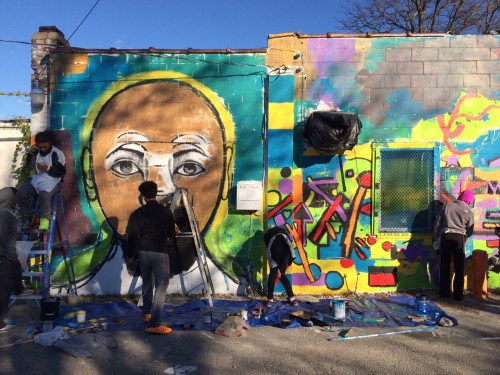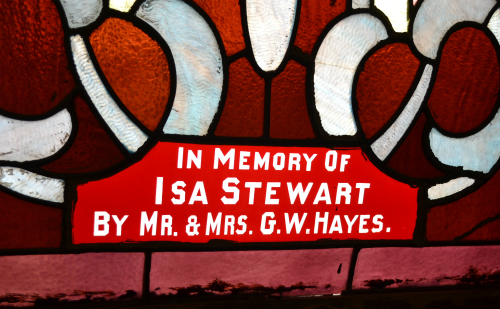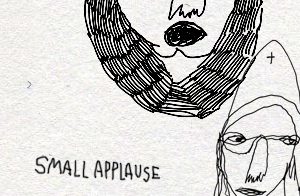Earlier this year, in the second installment of our interview with local historian Matt Siegfried on slavery, the fight for emancipation, and the role played by Ypsilantians in that struggle, we heard the story of a man named HP Jacobs, a runaway slave from Alabama who made his way to Ypsilanti, became a janitor at what is now Eastern Michigan University, and then went on to found both a church and a school for black children here, before heading back south for several years after the Civil War, where he served in the Mississippi State Senate, helped found what is now Jackson State University, and, at the age of 65, become a doctor. Well, today, an incredible group of local teens from Ypsi Community Schools started work on a mural recognizing these many accomplishments of HP Jacobs.
Not seen in the above photo, which I took this afternoon, are Ypsilanti Community High School art teacher Lynne Settles and Jackson artist Doug Jones, both of whom, as I understand it, were instrumental in making this happen… The mural, which, according to Jones, should be finished next weekend, is on the side of Currie’s barbershop, on Harriet Street.
For those of you who may not have read the interview with Siegfried referenced above, here’s the portion of our discussion about Jacobs, followed by a short video of the local historian talking about Jacobs and his local contributions.
MARK: What about other stories concerning the lives of former slaves in Ypsilanti? Are there any folks that we didn’t talk about last time that you think people should know about?
MATT: A name that must be mentioned is HP Jacobs, born into slavery in Alabama as Samuel Hawkins. He learned to read and write and forged freedom papers for his extended family. They left Alabama on July 24, 1856 and arrived in Canada on August 19th. There he was baptized by Rev. William Troy and shed his slave name, taking the name of HP Jacobs.
He then came back to Ypsilanti in the late 1850s and worked as the janitor for the Normal College (now EMU). While here, HP Jacobs founded Second Baptist, still active over 150 years later, and became its first pastor. Both black churches here, Second Baptist and Brown AME, were founded by fugitives from bondage and would have undoubtedly been deeply involved as their Detroit sister churches were, in the struggle for freedom. The stained-glass windows at Brown AME commemorate some of those very freedom-seekers, and are, in my opinion, among the most important historic treasures in all Ypsilanti.
[note: Our discussion of Isa Stewart can be found in part one of this interview.]
MARK: I’d never heard of Jacobs. What else can you tell us about him?
MATT: Well, he also helped to organize a school for Ypsilanti’s black children. His was the most prominent black voice in Ypsilanti during the Civil War period, leading marches, organizing rallies and speeches and participating in the statewide 1863 Michigan Colored Men’s Convention held in Ypsilanti. He may well have been active in the Underground Railroad, for he was connected to many of the most militant leaders in Detroit through the Baptist Church and 1863 convention, and as he was a veteran of the road himself.
He enrolled his daughters in the Normal (blacks could always study at the Normal) and his daughters (and granddaughters) would become the most celebrated area musicians of their day. When they graduated in their early teens, he took the family to Natchez, Mississippi. There he founded the Natchez Seminary, a school for recently freed slaves, which is now known as Jackson State University.
He would be elected to the Mississippi State Senate twice and Natchez City Council during Reconstruction… from slave to Senator in ten years. He helped to rewrite Mississippi’s constitution so it could be readmitted into the Union. He was also founder and first President of the Missionary Baptist Convention, the state’s first black Baptist authority. His children would later return to Ypsilanti and live here for decades at the center of black social life. His daughters, and this is the 1870s, would retain their maiden names, hyphenating Jacobs with their husbands’ surnames. Anna Jacobs-Dehazen taught music from her front room on South Adams Street.
HP Jacobs would travel the country, often returning to Ypsilanti to visit his family and speak as an honored guest at Emancipation Day, the generations-long celebration Ypsilanti held on August 1st in conjunction with other black communities. Nothing underlines Ypsi’s role in the freedom struggle like Emancipation Day, which would sometimes bring thousands of people in the City. [Right: Ypsilanti Commercial, July 23, 1886]
Late in life, he left the church and got his medical degree, becoming a doctor for black migrants out west. Recently, there has been a move to rename Jackson State University after him. There are dozens of Ypsilanti newspapers articles from the period which mention him, his activity and role. This was the one-time janitor at EMU… and perhaps the most important black man to ever call Ypsilanti home.
As a historian, I want to know what happened between then and now to bring us to a point where, today, no one in Ypsilanti knows him, the most important black Ypsilantian of the era.
[If you’re interested, video also exists of Siegfried talking with Ypsi students about Jacobs and why his legacy is so important.]














7 Comments
The Washtenaw Interfaith Coalition for Immigrant Rights teen group will also be unveiling a mural soon in downtown Ypsilanti, on the side of Dos Hermanos.
I have to say that I really like the internet. Instead of this mural just appearing, it is nice to have the whole backstory.
Too bad it is being painted with child slave labor.
Hopefully, EOS will be out there fighting for their rights.
Pete’s reference to EOS will be explained here.
http://markmaynard.com/2015/03/ann-arbor-awesome-foundation-awards-grant-to-immigrant-teen-group-in-ypsilanti-for-mural-project/
“Work consists of whatever a body is obliged to do, and that Play consists of whatever a body is not obliged to do.” — EOS via Tom Sawyer via Mark Twain.
November 11, 2014 at 11 am at Currie’s Barbershop (432 Harriet) will be the unveiling ceremony for the mural honoring HP Jacobs done with Ypsilanti High School students. Ypsilanti Mayor Amanda Edmonds will be on hand as we celebrate art, history, community, and our youth.
Please join and invite friends, coworkers, family and all those who may be interested. We hope this is the first of a series of murals. Thank you so much to everyone who has supported this project, it would not have been possible without a hundred small gifts.
Unbelievable Folks ! The things Rev.Dr. Jacobs and others had to endure in order to achieve freedom and education in America . Because of Dr.Jacobs , Jackson State University in Jackson,Mississippi is known as “The Family and Urban University “ . We never give up on achievements. #TheeILove
3 Trackbacks
[…] students who volunteered their time and talent to help commemorate the life and accomplishments of HP Jacobs, a runaway slave from Alabama who made his way to Ypsilanti, became a janitor at what is now […]
[…] a new mural on the south side of Ypsi commemorating the incredible life and accomplishments of HP Jacobs, a runaway slave from Alabama who made his way to Ypsilanti, became a janitor at what is now […]
[…] What did you learn from the first mural you did here in Ypsilanti, the one of HP Jacobs? And, given your experiences last time, are you doing anything differently this […]